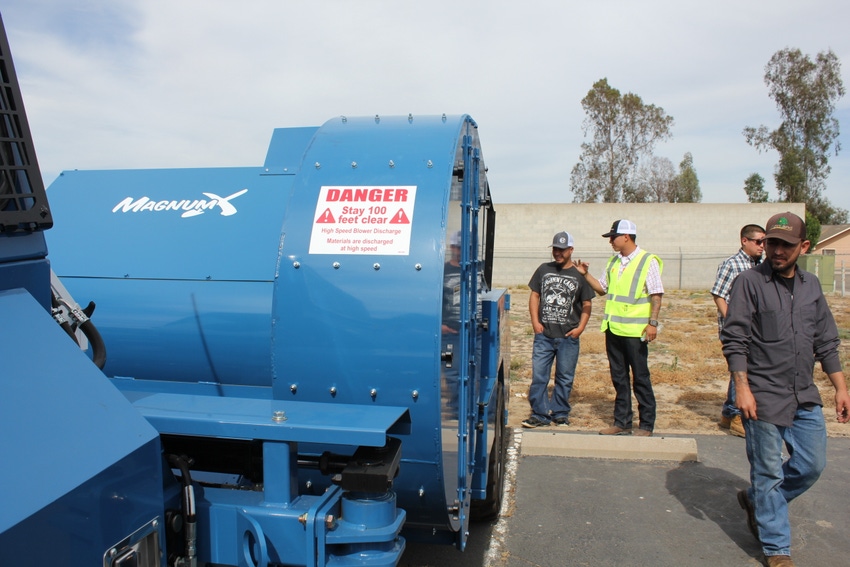August 17, 2016

Nut harvest is a dangerous time of the year when arms and fingers are sometimes amputated, people can be mangled by heavy machinery, and other injuries may be sustained on the job if precautions are not taken.
That’s why representatives from tree nut operations attended a safety workshop to learn more on how to help protect employees during nut harvest.
Presenters included Irma Ramirez and Anna Genasci, education specialists with AgSafe; and Elda Brueggemann, environmental and safety services director with the Western Agricultural Processors Association. They guided participants through case studies based on actual mishaps, some deadly, that were documented by Cal-OSHA.
One related to an attempt to clear a blockage from a blower without first turning it off. Another involved a worker whose loose-fitting jacket was caught in the vertical spinner of a spreader operated in a walnut orchard to apply gypsum.
A repeated solution for avoiding such accidents was echoed by Gabe Lorente, loss control consultant with Der Manouel Insurance Group in Fresno, who said, “Training-training- training.”
Lorente and others also said discipline may be necessary at times, and Ramirez said “motivation should be hand in hand with discipline.” The latter can involve providing incentives such as gift cards, cash, or caps to reward proper precautionary actions.
Here are 12 safety pointers shared by the presenters.
1 - Discuss any hazards during nut harvest and ways to prevent them, including wearing personal protective equipment including goggles, hearing protection, and dust masks. Demonstrate how to use the equipment.
2 - Identify pieces of equipment and tools commonly used during harvest and discuss the potential hazards. Have in place lockout-tag out procedures for every piece of equipment used.
3 - Don’t wear loose clothing that can get caught in moving machinery that includes a power takeoff (PTO).
Ramirez showed how some safety vests are designed so parts of it, fastened at points by Velcro, pull away to avoid snaring the entire vest. Taking an extra safety vest can be wise, she explained, since it can be used to mark hazards in an orchard such as a gate which might otherwise not be quickly recognized.
4 – Keep a safe distance from PTO-powered equipment, keep PTO shields on at all times, and check for missing or damaged shields before hooking up the PTO.
5 - Be able to communicate with others using radio phones or walkie talkies if cell phones might be out of service. Or have someone check on the welfare of workers periodically if they can’t be reached with any device.
6 - Limited visibility can lead to serious injuries. Sometimes a solution is as simple as cleaning a windshield or goggles periodically.
7 - When working at night, harvesting equipment should be able to light up 50 feet ahead.
8 - Avoid distractions, including non-work-related cell phone calls. One participant discussed a phone app that can respond to callers with a message to the effect, “I will get back to you; I am driving right now.”
9 - Inspect orchards before starting work to identify hazards that should be marked or avoided by employees on the ground around heavy equipment. Require all employees to wear reflective clothing or vests. Limit the number of the ground crew to only those people who need to be there.
10 - When moving equipment on a public roadway, be sure there is signage indicating it is a slow moving vehicle. A flagger, lookout, or guide vehicle with flashing lights may be needed. The timing of movement should include considerations of when traffic might be light and driving conditions best, including the avoidance of fog.
11 - Allow only trained and authorized employees to conduct any service, maintenance, or repair on equipment. Create a checklist for equipment inspections.
Juan Carlos Rodriquez, a shop manager at Pistachio Harvesting Inc. in Madera, Calif., said an un-trained seasonal worker should not be allowed to clear clogged machinery.
“Call a mechanic,” Rodriguez said.
12 - The amount of dust created during almond harvest can be reduced by starting with a clean orchard, not setting sweeper heads too low, avoiding extra sweeper passes, and moving slowly.
You May Also Like




